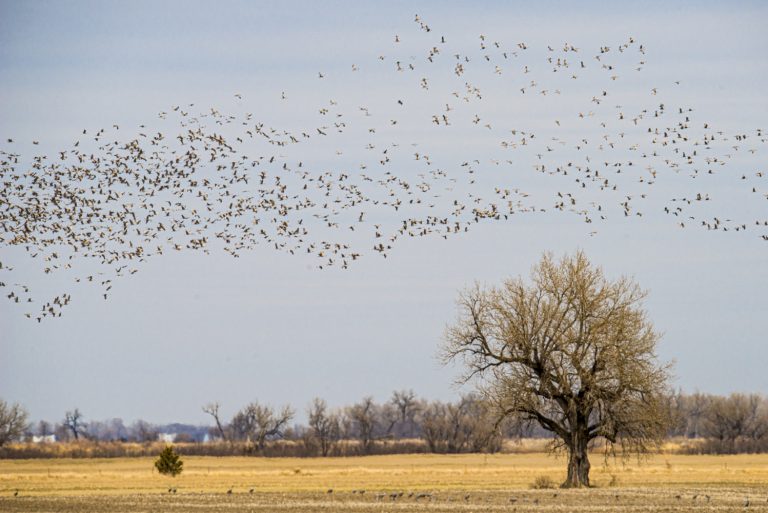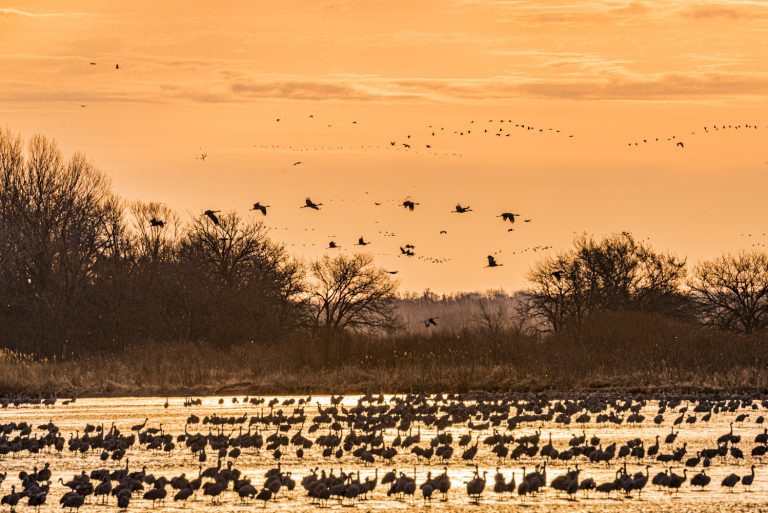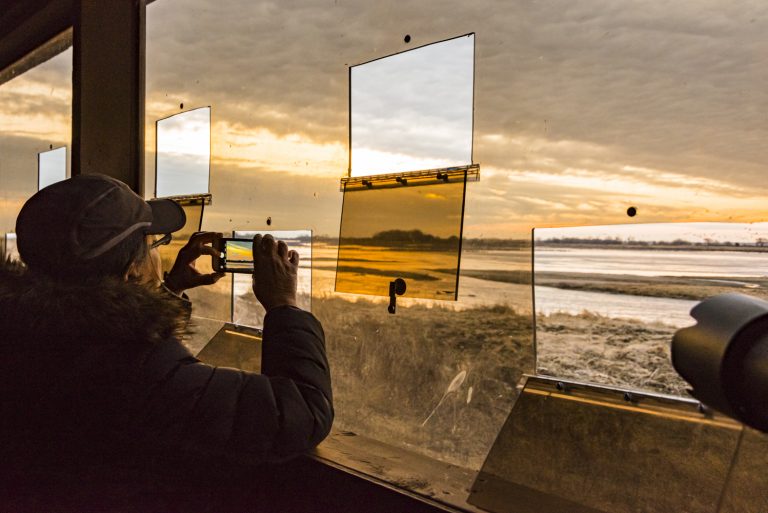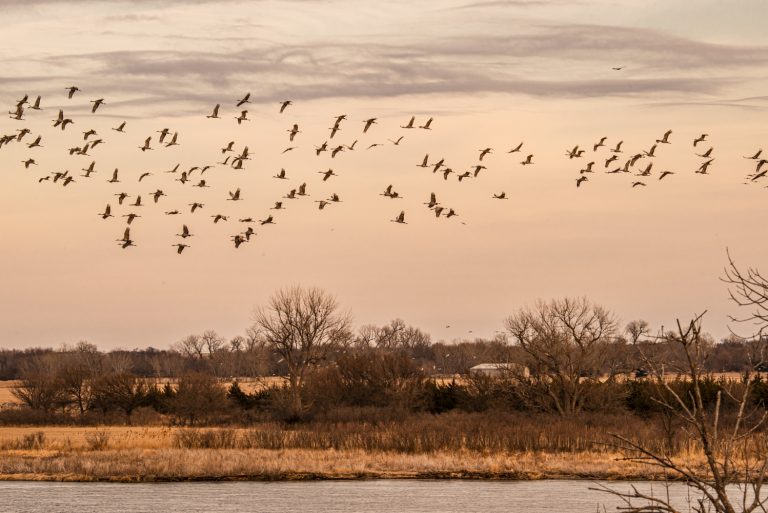Central Platte River Basin
Mississippi River Basin
|
NEW ESRI StoryMaps: What's On Our Shelves & NWNL Song Library & No Water No Life ESRI |
Mississippi River Basin
Brice Krohn
President of Crane Trust
Alison M. Jones
NWNL Director and Photographer
Carolyn Bowman
Author and Traveler at Kearney Nebraska
All images © Alison M. Jones, unless otherwise noted. All rights reserved.
Thanks to Brice Krohn, a NWNL Team watched cranes roosting in the Platte River’s Big Bend Region. At dusk we visited Crane Trust’s Hill Blind and at dawn their Beach Blind. As well as providing viewing opportunities for the public, the Crane Trust was established as mitigation for the Grayrocks Dam and Diversion of North Platte Project1 to protect habitat for migrating sandhill cranes, endangered whooping cranes, as well as buffalo and other wildlife. Brice also shared his knowledge of riverine grass prairies, tree wind breaks, tornado impacts on snow geese flocks, 10-million-year-old crane fossils, the plethora of corn left for cranes after the 1960’s corn boom, and recent no-till farming and youth education programs in Nebraska. Brice is indeed a broadly focused Platte River Basin steward.

1North Platte Project for water reclamation includes 5 storage dams; 4 diversion dams; a pumping plant; a powerplant; and about 2,000 miles of canals, laterals, and drains.
NWNL Brice, you’ve been a marvelous host to us the last few days. Thank you for inviting us to Crane Trust lectures on Platte River Basin biodiversity and to your river blinds to watch the cranes. What brought you to the Crane Trust here near Kearney, Nebraska?
BRICE KROHN I went to college in here in Kearney, Nebraska, studying biology with a wildlife emphasis. I was a seasonal and then permanent employee for the U.S. Fish and Wildlife Service for 12 years. In June 2012, I moved to the Crane Trust and have been here since. I’ve focused on land management and habitat management and am now Vice President here.
I’ve always had a liking for this area. My grandparents were from Lexington, Nebraska, 35 miles from here, so I used to come out here in the summer. Thus, I’ve always been exposed to the Platte River. It’s a great place to live, so I’m still here.
NWNL So you came here as a boy?
BRICE KROHN Yeah, I sure did. Every summer. It was excellent. The cranes always came through, using this Central Flyway. Back then, the Platte River stretch in which the cranes pause on their migration, which we call “the hourglass,” used to be wider than it is.
It was 80 miles wide here at its chokepoint, but now their flyway is only 50 miles wide. This is the only place in the world that cranes congregate like they do here: north and south of the river 20 miles, and then east west about that 50 to 80 miles wide.

NWNL Last night, about 8:00 pm, while driving on the Interstate from the town of North Platte, we saw a couple cranes. Then, all of a sudden, we saw huge patches of them as we got closer to Kearney — more and more and more. Mile by mile, we watched masses of them descend into the river.
BRICE KROHN It is amazing. Even if folks aren’t really into birds, the sheer spectacle of their migration is very special. I think it really turns people. It’s a life-changing experience for folks, even locals, to sit in a blind along the river, or just stop and enjoy seeing that phenomenon actually happening. It’s a life-changing moment. During the day, they can be seen from easily accessed farm roads in wet meadows and crop fields. You know they’re out there; but then you can see their behavior as they are feeding and socializing.
NWNL Where does Crane Trust’s funding come from?
BRICE KROHN Our endowment is dependent on the Trustees. Annually, 4 to 6% of the endowment can be used. For the remaining balance needed each year, we fundraise for donations and grants. Working with other conservation partners is my big push, and it’s worked well. We partner with other folks to use and share equipment and share needed resources.
NWNL Do you accept money from corporations?
BRICE KROHN Yes. As we increase our outreach, we’re really opening our doors. Chuck Cooper, our CEO, has visited with other folks and helped fund the Crane Trust. We just began a program of bringing folks here to spend the night in our riverside cabins. That immerses people in the crane migration, and then more people want to come to see it. We’re also opening the Trust’s cabins and blinds throughout the rest of the year for visitors. If there’s water in the river, we have opportunities to spend the night, go kayaking and ride bikes. We don’t make have to makenew prairie trails as this is already an accessible area. So, we’re not impacting the prairie.
As we try find new funders to help us manage habitat and land, Chuck takes the lead in fundraising; and I take the lead on the daily operations, essentially overseeing everything going on in the Nature Visitor Center, and all the different management actions.

NWNL What percentage of the money you raise in a year is from small donations from individuals, like $25 to $100?
BRICE KROHN I would say 80% of donations. Last year we begin seeking ways to find larger donations. It does takes time. We’re a smaller nonprofit, private organization.
NWNL No Water No Life has many of the same challenges in fundraising. But we’ll do what we can to spread the word of what Crane Trusts provides for all who are inspired to come witness this magnificent annual migration – and thus support the work you are doing. Thank you very much for your time and for the access to the cranes you have provided for us this month.

Posted by NWNL on October 17, 2019.
Transcription edited and condensed for clarity by Alison M. Jones.
All images © Alison M. Jones, unless otherwise noted. All rights reserved.
